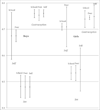Understanding multiple levels of norms about teen pregnancy and their relationships to teens' sexual behaviors
- PMID: 25104920
- PMCID: PMC4120999
- DOI: 10.1016/j.alcr.2013.12.004
Understanding multiple levels of norms about teen pregnancy and their relationships to teens' sexual behaviors
Abstract
Researchers seeking to understand teen sexual behaviors often turn to age norms, but they are difficult to measure quantitatively. Previous work has usually inferred norms from behavioral patterns or measured group-level norms at the individual level, ignoring multiple reference groups. Capitalizing on the multilevel design of the Add Health survey, we measure teen pregnancy norms perceived by teenagers, as well as average norms at the school and peer network levels. School norms predict boys' perceived norms, while peer network norms predict girls' perceived norms. Peer network and individually perceived norms against teen pregnancy independently and negatively predict teens' likelihood of sexual intercourse. Perceived norms against pregnancy predict increased likelihood of contraception among sexually experienced girls, but sexually experienced boys' contraceptive behavior is more complicated: When both the boy and his peers or school have stronger norms against teen pregnancy he is more likely to contracept, and in the absence of school or peer norms against pregnancy, boys who are embarrassed are less likely to contracept. We conclude that: (1) patterns of behavior cannot adequately operationalize teen pregnancy norms, (2) norms are not simply linked to behaviors through individual perceptions, and (3) norms at different levels can operate independently of each other, interactively, or in opposition. This evidence creates space for conceptualizations of agency, conflict, and change that can lead to progress in understanding age norms and sexual behaviors.
Keywords: Add Health; Social norms; adolescent sexual behavior; age norms; gender; peer influence; school contexts; social psychology; teen pregnancy.
Figures




Similar articles
-
College-Bound Teens' Decisions about the Transition to Sex: Negotiating Competing Norms.Adv Life Course Res. 2011 Jun;16(2):83-97. doi: 10.1016/j.alcr.2011.05.001. Adv Life Course Res. 2011. PMID: 22439133 Free PMC article.
-
Bundles of Norms About Teen Sex and Pregnancy.Qual Health Res. 2015 Sep;25(9):1283-99. doi: 10.1177/1049732314557086. Epub 2014 Nov 11. Qual Health Res. 2015. PMID: 25387911
-
Norms, Attitudes, and Preferences: Responses to a Survey of Teens about Sexually Transmitted Infection and Pregnancy Prevention.J Pediatr Adolesc Gynecol. 2017 Feb;30(1):29-34. doi: 10.1016/j.jpag.2016.09.003. Epub 2016 Sep 20. J Pediatr Adolesc Gynecol. 2017. PMID: 27663300 Free PMC article.
-
Sexual activity and contraceptive use: the components of the decisionmaking process.Stud Fam Plann. 1998 Jun;29(2):154-66. Stud Fam Plann. 1998. PMID: 9664629 Review.
-
Adolescent sexuality.Pediatr Clin North Am. 1988 Dec;35(6):1271-89. doi: 10.1016/s0031-3955(16)36583-x. Pediatr Clin North Am. 1988. PMID: 3059299 Review.
Cited by
-
Gender Perspectives on Social Norms Surrounding Teen Pregnancy: A Thematic Analysis of Social Media Data.JMIR Pediatr Parent. 2019 Sep 17;2(2):e13936. doi: 10.2196/13936. JMIR Pediatr Parent. 2019. PMID: 31536963 Free PMC article.
-
Perceived Costs and Benefits of Early Childbearing: New Dimensions and Predictive Power.Perspect Sex Reprod Health. 2016 Jun;48(2):83-91. doi: 10.1363/48e9116. Epub 2016 May 13. Perspect Sex Reprod Health. 2016. PMID: 27175569 Free PMC article.
-
Norms as Group-Level Constructs: Investigating School-Level Teen Pregnancy Norms and Behaviors.Soc Forces. 2014 Sep;93(1):241-267. doi: 10.1093/sf/sou063. Soc Forces. 2014. PMID: 26074628 Free PMC article.
-
Family, Peer, and School Influences on Children's Developing Health Lifestyles.J Health Soc Behav. 2018 Mar;59(1):133-150. doi: 10.1177/0022146517750637. Epub 2018 Jan 3. J Health Soc Behav. 2018. PMID: 29298103 Free PMC article.
-
Social predictors of the transition from anomie to deviance in adolescence.PLoS One. 2022 Jun 22;17(6):e0269236. doi: 10.1371/journal.pone.0269236. eCollection 2022. PLoS One. 2022. PMID: 35731720 Free PMC article.
References
-
- Bearman PS, Brückner H. Promising the future: Virginity pledges and first intercourse. American Journal of Sociology. 2001;106(4):859–912.
-
- Berthoz S, Armony JL, Blair RJR, Dolan RJ. An fMRI study of intentional and unintentional (embarrassing) violations of social norms. Brain. 2002;125:1696–1708. - PubMed
-
- Billari FC, Liefbroer AC. Should I stay or should I go? The impact of age norms on leaving home. Demography. 2007;44(1):181–198. - PubMed
-
- Brewster KL. Neighborhood context and the transition to sexual activity among young Black women. Demography. 1994;31(4):603–614. - PubMed
-
- Brückner H, Martin A, Bearman PS. Ambivalence and pregnancy: Adolescents' attitudes, contraception use and pregnancy. Perspectives on Sexual and Reproductive Health. 2004;36(6):248–257. - PubMed
Grants and funding
LinkOut - more resources
Full Text Sources
Other Literature Sources
